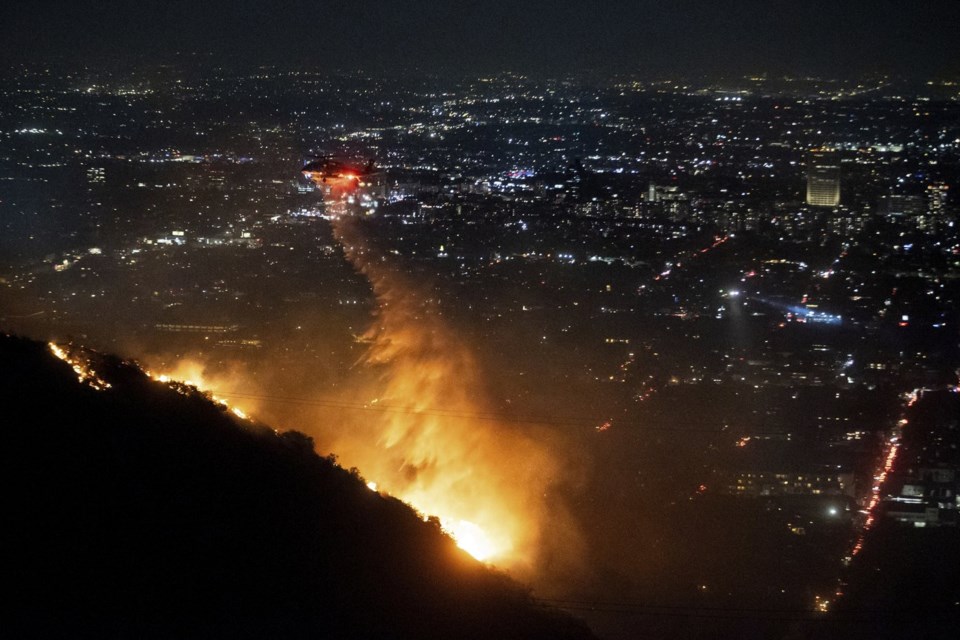As wildfires blaze trails of destruction in Los Angeles and force tens of thousands of people from their homes, disaster preparedness may be top of mind, even for those far from immediate danger.
Experts say it's best to have a plan ahead of a disaster, particularly given the increasing frequency and severity of extreme weather events.
"Our current system of emergency response policy has completely focused on the physical aspect," said Haorui Wu, Canada Research Chair in resilience at Dalhousie University.
"However the (way) disaster most impacts people is about social psychology — our mental health or our social well-being."
To prepare mentally for a disaster, he said, people should read up on what extreme weather events are most likely to affect their geographical area. In British Columbia, that might be wildfires or flooding caused by atmospheric rivers. In Atlantic Canada, it's more likely to be hurricanes.
People who know what to expect are more resilient when crisis strikes, Wu said.
On a social level, he recommends people get in touch with their neighbours and make sure they have each other's contact information so they can connect both during and after a catastrophe.
"Humans are social animals," he said.
Without family and neighbours, people might get sucked into social media silos that lead them to catastrophize, rather than ground them in supportive communities.
Canada lacks a "culture of resiliency," he said, and that needs to change.
As for physical preparation, Wu noted that the federal government has solid suggestions.
PLAN FOR LEAVING
Canada's Department of Public Safety and Emergency Preparedness recommends making a plan with your family that takes into account everyone's needs, including those of older adults, children and pets.
Consider how you'll get in touch if you aren't already together if disaster strikes. Come up with two options of where you might meet: somewhere near home, and somewhere outside of your immediate neighbourhood.
Communicate with your neighbours ahead of time. Public Safety suggests forming teams of "block buddies" to help more vulnerable neighbours get out safely.
Figure out how you'll get out of your area — what routes will you take and where will you go? Consider that many people might be fleeing at once.
In Los Angeles, officials are recommending people leave before evacuation orders come into force so they don't get caught up in gridlock.
PLAN FOR WHAT YOU'RE LEAVING BEHIND
In many cases, there are things you can do to protect your home when you flee.
During a wildfire, for instance, the federal government suggests turning off your propane or natural gas before you leave. You can also remove fire hazards around the home such as dried-out foliage and firewood, along with propane and other combustibles. It also recommends closing all windows and doors, along with covering vents and other openings to limit smoke entering the home. You can leave a ladder propped up against the house to help firefighters.
If you live in a flood-prone area, Public Safety recommends stocking up on sandbags and reaching out to your utility provider to ask whether there are any special precautions required to safeguard electrical, gas or other heating equipment.
It also recommends moving important documents to a higher elevation to protect them from water damage,
PACK A KIT
Public Safety Canada also recommends creating an emergency kit that includes necessities like bottled water, non-perishable food, a manual can-opener, a flashlight and radio that operate either with a crank or removable batteries — not ones that require charging — and a first aid kid.
For those who don't want to make their own, the Canadian Red Cross sells ready-made emergency preparedness kits that also include a plasticky, windproof blanket that traps body heat, a multi-function tool and water purification tablets.
Your kit should also include photocopies of important documents, a spare key to your home and car, a bit of cash and any other essentials like prescription medicine, baby formula, assistive devices or pet food.
HUNKERING DOWN IN AN EMERGENCY
Public Safety says it's always a good idea to have extra non-perishable food in the home. Your emergency kit may also come in handy in this case.
It suggests getting a crank-powered radio so you can keep up to date on official instructions, even if you lose power. Public safety also recommends keeping extra batteries or a charger for a mobile device in your emergency kit — particularly solar-powered, crank or vehicle chargers.
For people who have a landline, the government suggests keeping at least one corded phone in the house because cordless landlines don't work when the power goes out.
If you hear bad weather is coming, stock up on several days' worth of food.
If you live alone and have time to prepare, Wu suggested trying to connect with others to help look after each other. That may help with both physical safety and mental well-being, he said.
For those with kids, the federal government suggests maintaining familiar routines, like mealtimes and regular bedtime hours, to keep them grounded in some sort of normalcy. It also recommends telling kids about what you are thinking and feeling, so they don't feel isolated in their emotions.
This report by The Canadian Press was first published Jan. 14, 2025.
Nicole Thompson, The Canadian Press



